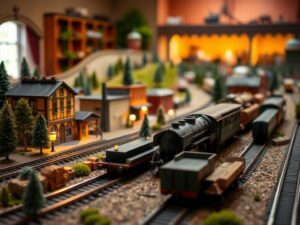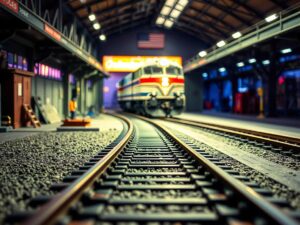How to Set Up Automatic Train Control Using DCC
How to Set Up Automatic Train Control Using DCC
How to Set Up Automatic Train Control Using DCC
Hey fellow railroaders! Today we’re diving deep into the fascinating world of automatic train control using DCC, a topic that might seem intimidating at first but is surprisingly achievable even for beginners. Imagine trains seamlessly moving across your layout, obeying signals and maintaining consistent speed without your constant intervention. Thatâs the magic of DCC automation!
This detailed guide will walk you through setting up automatic train control with DCC (Digital Command Control) in HO Scale, explaining key concepts along the way and offering tips for both beginners and experienced model railroaders. Ready to transform your layout into a marvel of automated railway wonder? Let’s roll!
Understanding the Basics: What is DCC?
Before we jump into automation, let’s briefly touch upon DCC itself. It’s a revolutionary technology that allows individual control over each locomotive and rolling stock on your layout. Unlike traditional model train setups (DC) where trains share the same power source, DCC uses digital signals to communicate with locomotives. This means you can:
- Control multiple trains simultaneously: Assign each locomotive a unique address, allowing independent speed control, direction changes, and lighting functions.
- Achieve smoother operation: No more jolting starts and stops! DCC delivers precise power regulation for a seamless ride.
- Introduce realism: Simulate braking systems, horn blasts, whistles, and other sounds to bring your railroad to life.
Taking Automation Further: Introducing Automatic Train Control (ATC)
Automatic Train Control adds another layer of sophistication to DCC by allowing your trains to run automatically along predetermined paths guided by signals and track-mounted sensors. Imagine this: your train approaches a signal displaying a red light, it automatically slows down and comes to a halt. As the signal turns green, it smoothly accelerates and continues its journey.
This level of automation not only saves you from constantly monitoring and adjusting your trains but also creates a much more immersive and realistic railroad experience.
Key Components for Setting Up Automatic Train Control with DCC:
-
DCC System: The foundation of our setup. Choose a reliable brand like Lenz, ESU, Digitrax or Atlas that aligns with your budget and needs.
-
Power Supply: This provides the electricity to power your DCC system and track layout.
-
Decoder Installation: Each locomotive needs a DCC decoder. These tiny chips allow them to “speak” with the DCC command center.
-
Automatic Train Control Accessory Modules:
These are the brains behind the operation. Some popular options include:
-
Programmable Track Controllers (PTCs): Offer a high level of automation, enabling route setting, signal control, and occupancy detection using sensors.
-
DCC Expansion Boards: Many DCC systems have expansion slots allowing you to add specialized boards for automation, including sensor management and advanced locomotive programming.
-
Sensors & Feedback Modules: Essential for the “intelligence” of your ATC system. Types include:
-
Track Switches: Provide feedback when a train is entering or leaving specific sections.
-
Point Motors (Rocking Motors): These automate the changing of turnout positions. Often combined with sensor detection.
-
Occupancy Sensors: Detect if a locomotive or car is occupying a particular section of track, crucial for signaling and route control.
-
-
-
Command Station Software/Hardware: The software or user interface through which you program and monitor your DCC system’s operations.
Setting Up Automatic Train Control – A Step-by-Step Guide:
Letâs break down the setup process into manageable steps:
-
Laying the Foundation: Ensure your layout has a solid track plan, complete with essential turnouts (points), switches, and planned stopping points for future integration of ATC signals and occupancy sensors.
-
Wiring and Power Up: Follow your DCC system’s instructions carefully to wire the power supply, command station, and accessory outputs for controllers and signal units. Ensure a strong connection!
-
Decoder Installation & Programming: Equip each locomotive with its decoder and follow the manufacturer’s programming guide. Assign unique addresses to ensure each engine can be individually controlled.
-
Connect Sensors:
Carefully wire your occupancy sensors, track switches, and point motors into your DCC system’s accessory outputs following the specific connections detailed in the wiring diagram provided with your accessories. Double-check all connections for security!
-
ATC Software Setup: Using the command station software or hardware interface, create your automated train routes, programming stop points, signals, and the appropriate sensor interactions. You may need to consult user manuals for your specific software to master the configurations.
-
Testing & Refining: Run test trains through pre-programmed routes, observing signal response, braking, acceleration, and adherence to set speed limits. Use your command station’s programming functions to fine-tune each aspect of your automatic train control system until it operates smoothly and seamlessly.
Pro Tips for Leveling Up Your Automatic Train Control:
- Use Rail Signals:
Incorporate realistic-looking rail signals into your layout, powered by your ATC module. Train response to green, yellow, and red lights will elevate realism and safety on your model railroad.
- Add DCC Feedback Track:
Implement dedicated “feedback” track sections (loops or segments) that are integrated with your command station. This lets you monitor a train’s exact location for even more precise automation control, allowing complex route changes and advanced functions like car-switching.
- Sound Effects Integration: Enhance your automatic system by integrating sound modules that trigger authentic engine sounds (honking, air brakes, whistling) based on signal changes and train movements. This adds a new dimension to your layout’s realism!
Conclusion: Embrace the Future of Model Railroading
Automatic train control using DCC opens up a world of possibilities for model railroaders of all skill levels. From smooth and efficient operations to an immersive and interactive experience, the benefits are undeniable. With careful planning, consistent effort, and our comprehensive guide, you’re well on your way to mastering this fascinating technology. So get those wires humming, program those trains, and witness the magic of automation on your very own HO Scale masterpiece!
*Let me know in the comments what you found most useful in this guide and what specific DCC questions or challenges youâd like help with in the future. Remember, building a great model railroad is about sharing knowledge and having fun along the way. Happy railfanning! *




